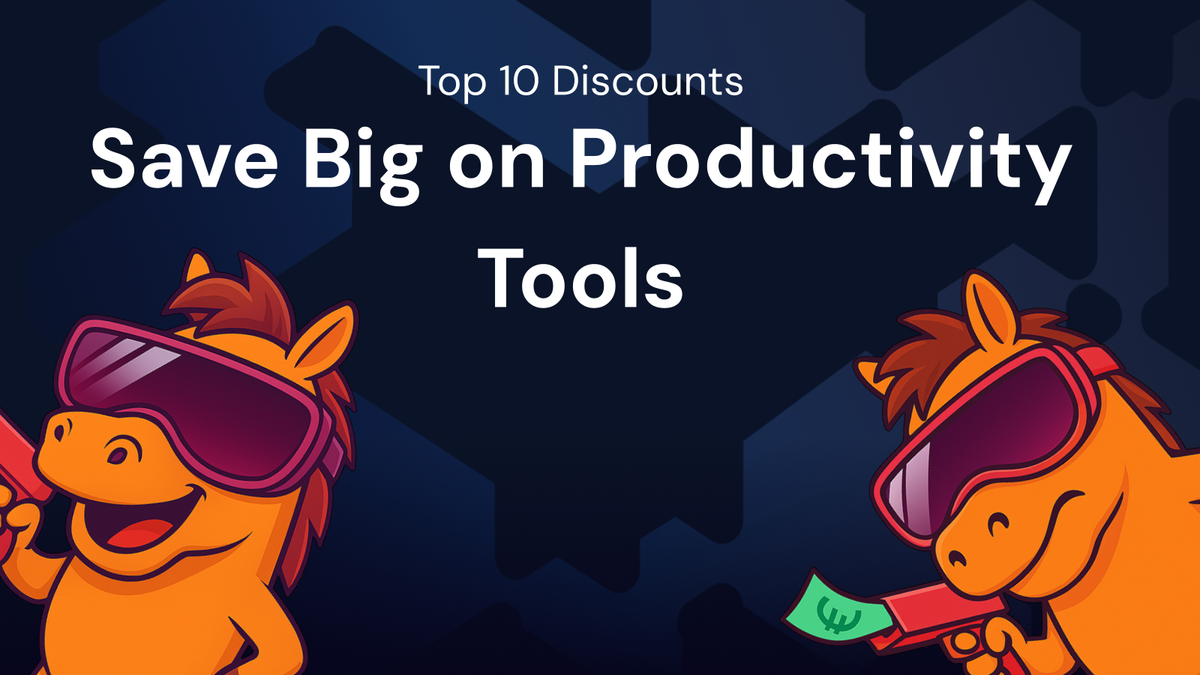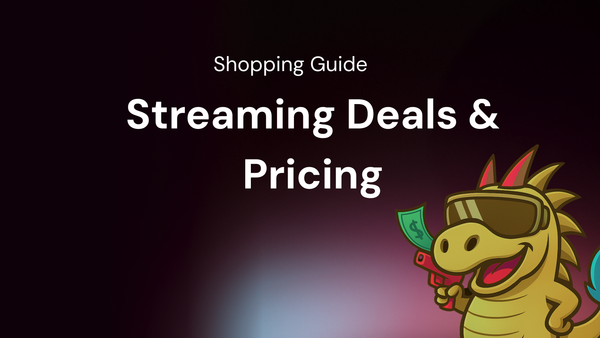Top 10: Save Big on productivity tools Using discounts

Top 10: Save Big on Productivity Tools Using Discounts
In today's fast-paced world, productivity is paramount. Whether you're a freelancer juggling multiple projects, a student tackling a heavy course load, or a professional striving for career advancement, having the right tools can make all the difference. Fortunately, achieving peak performance doesn't always require a hefty investment. This article unveils ten strategies for saving big on productivity tools, empowering you to optimize your workflow without breaking the bank. We're not recruiters, sellers, or service providers; our aim is solely to equip you with the information you need to find the best deals.
1. Explore Student and Educational Discounts
Unlocking Significant Savings: A often overlooked avenue for discounts is through educational institutions. Many software and service providers offer significantly reduced rates for students, teachers, and faculty members.
Who Qualifies? Typically, you'll need to be enrolled in a recognized educational institution (university, college, or even some vocational schools) and be able to provide proof of enrollment. Some offers may also extend to educators and staff members.
Where to Look:
- Software Developers' Websites: Directly check the websites of popular productivity tool providers. Look for sections labeled "Education," "Students," or "Academic Pricing." Companies like Microsoft, Adobe, and JetBrains frequently offer substantial discounts.
- Educational Marketplaces: Websites like "Academic Superstore" and "JourneyEd" specialize in providing software and hardware at discounted prices for students and educators.
- Your University/College: Many educational institutions have partnerships with software companies, providing students with exclusive access to discounted software. Check your university's IT department website or student resources portal.
Example: Adobe Creative Cloud offers a significant discount for students and teachers, providing access to its suite of creative applications (Photoshop, Illustrator, InDesign, etc.) at a fraction of the regular price. Microsoft 365 also offers student discounts, providing access to Word, Excel, PowerPoint, and other essential productivity tools.
Important Note: Be sure to carefully review the terms and conditions of the educational discount. Some licenses may be limited to academic use only, while others may have restrictions on commercial use.
2. Take Advantage of Free Trials and Freemium Models
Test Before You Invest: Before committing to a paid subscription, always explore free trials and freemium versions of productivity tools. This allows you to evaluate the software's features and functionality to determine if it truly meets your needs.
Free Trials: Many software companies offer free trials ranging from a few days to a month. Use this period to thoroughly test the software's capabilities and assess its compatibility with your workflow.
Freemium Models: Some tools operate on a "freemium" model, offering a basic version of the software for free with limited features. This allows you to use the core functionality of the tool without paying a subscription fee. You can then upgrade to a paid plan to unlock additional features and functionality if needed.
Examples:
- Project Management: Trello and Asana offer free plans with basic project management features.
- Note-Taking: Evernote and OneNote offer free versions with sufficient storage and functionality for most users.
- Password Management: LastPass and Bitwarden offer free plans for individual users.
Maximizing Free Trials:
- Plan Your Evaluation: Before starting the free trial, identify the key features you want to test and create a plan for evaluating the software.
- Utilize Tutorials and Documentation: Take advantage of available tutorials and documentation to learn how to use the software effectively.
- Track Your Usage: Monitor your usage during the trial period to determine if the software is truly improving your productivity.
3. Seek Out Seasonal Sales and Black Friday Deals
Timing is Everything: Many software and service providers offer significant discounts during seasonal sales events, such as Black Friday, Cyber Monday, and end-of-year sales. Keep an eye out for these opportunities to snag great deals on productivity tools.
Black Friday and Cyber Monday: These are two of the biggest shopping days of the year, with many software companies offering deep discounts on their products.
End-of-Year Sales: Many companies offer special promotions and discounts during the holiday season.
How to Prepare:
- Create a Wish List: Identify the productivity tools you need and create a wish list.
- Track Prices: Monitor the prices of your desired tools in the weeks leading up to sales events.
- Set Alerts: Sign up for email alerts from your favorite software companies to be notified of upcoming sales.
- Be Ready to Act Fast: Popular deals often sell out quickly, so be prepared to act fast when you see a good offer.
Example: You can often find discounts of up to 50% or more on popular software during Black Friday and Cyber Monday. This is a great opportunity to purchase premium productivity tools at a significantly reduced price.
4. Subscribe to Newsletters and Follow Social Media for Exclusive Offers
Stay Informed: Many software companies offer exclusive discounts and promotions to their email subscribers and social media followers. Subscribe to newsletters and follow your favorite companies on social media to stay informed about upcoming deals.
Email Newsletters: Sign up for the email newsletters of the productivity tools you're interested in. Companies often announce exclusive promotions and discounts to their subscribers.
Social Media: Follow your favorite software companies on social media platforms like Twitter, Facebook, and LinkedIn. Companies often announce flash sales and limited-time offers on social media.
Benefits of Following:
- Early Access: Get notified about sales and promotions before the general public.
- Exclusive Discounts: Access exclusive discounts and offers that are not available elsewhere.
- Contests and Giveaways: Participate in contests and giveaways for a chance to win free software licenses.
Example: Many companies offer a discount code to new email subscribers, providing an immediate opportunity to save on your first purchase.
5. Bundle Software and Services for Discounted Pricing
Unlock Package Deals: Some companies offer discounted pricing when you bundle multiple software programs or services together. This can be a great way to save money if you need more than one tool.
Software Suites: Consider purchasing software suites that include multiple productivity tools. For example, Microsoft 365 includes Word, Excel, PowerPoint, and other essential applications.
Bundled Services: Some companies offer bundled services that combine software with training, support, or other value-added features.
How to Find Bundles:
- Check Software Developers' Websites: Look for bundle deals on the websites of your favorite software companies.
- Explore Online Marketplaces: Online marketplaces like Amazon and StackSocial often offer bundled software packages at discounted prices.
- Contact Sales Representatives: Contact the sales representatives of software companies to inquire about potential bundle deals.
Example: Purchasing Adobe Creative Cloud is often more cost-effective than purchasing individual applications separately. The full suite provides access to a wide range of creative tools at a discounted price.
6. Leverage Referral Programs and Affiliate Links
Share the Savings: Many companies offer referral programs that reward you for referring new customers. If you know someone who could benefit from a particular productivity tool, refer them using your referral link to earn discounts or credits.
Referral Programs: When a referred user signs up for a paid subscription using your referral link, you may receive a discount on your own subscription or earn credits towards future purchases.
Affiliate Links: Some companies offer affiliate programs that allow you to earn a commission for every sale generated through your affiliate link.
Finding Referral Programs:
- Check Software Developers' Websites: Look for referral program information on the websites of your favorite software companies.
- Contact Customer Support: Contact customer support to inquire about referral program details.
Ethical Considerations:
- Disclose Your Affiliation: If you're sharing affiliate links, be transparent about your affiliation.
- Recommend Products You Trust: Only recommend productivity tools that you genuinely believe in and that you use yourself.
Example: Dropbox offers a referral program that rewards you with additional storage space for every new user you refer.
7. Consider Open-Source and Free Alternatives
Explore Cost-Free Options: Numerous open-source and free productivity tools are available that can rival the functionality of their paid counterparts. These options can be a great way to save money while still getting the tools you need to be productive.
Open-Source Software: Open-source software is free to use, modify, and distribute. Many open-source productivity tools are available that offer comparable functionality to paid software.
Free Software: Some companies offer free versions of their software with limited features. These free versions can be a good starting point for users who don't need all the bells and whistles of the paid versions.
Examples:
- Office Suites: LibreOffice and OpenOffice are free, open-source alternatives to Microsoft Office.
- Image Editing: GIMP is a free, open-source alternative to Adobe Photoshop.
- Video Editing: DaVinci Resolve offers a free version with powerful video editing capabilities.
Advantages of Open-Source:
- Cost-Effective: Open-source software is free to use, saving you money on licensing fees.
- Customizable: Open-source software can be customized to meet your specific needs.
- Community Support: Open-source software often has a strong community of users and developers who can provide support.
Important Note: While open-source and free software can be a great option, be sure to research the software thoroughly and ensure that it meets your security and privacy requirements.
8. Check for Group Discounts and Team Pricing
Collaborate and Save: If you're part of a team or organization, explore group discounts and team pricing options. Many software companies offer reduced rates for multiple users.
Team Plans: Many productivity tools offer team plans that provide access to the software for multiple users at a discounted price.
Group Discounts: Some companies offer group discounts to organizations or groups of individuals who purchase multiple licenses.
Negotiate for Better Deals: Don't be afraid to negotiate with software companies to get the best possible price for your team.
How to Find Group Discounts:
- Check Software Developers' Websites: Look for team pricing or group discount information on the websites of your favorite software companies.
- Contact Sales Representatives: Contact the sales representatives of software companies to inquire about potential group discounts.
Example: Project management tools like Asana and Trello offer team plans with discounted pricing for multiple users, making collaboration more affordable.
9. Explore Lifetime Deals and One-Time Purchase Options
Avoid Recurring Costs: Some software companies offer lifetime deals or one-time purchase options, allowing you to avoid recurring subscription fees. While these options may require a larger upfront investment, they can save you money in the long run.
Lifetime Licenses: A lifetime license grants you access to the software for the duration of its lifespan without requiring ongoing subscription payments.
One-Time Purchases: Some software companies offer one-time purchase options for specific versions of their software. This allows you to use the software indefinitely without paying a recurring fee.
Considerations:
- Upfront Cost: Lifetime deals and one-time purchases typically require a larger upfront investment.
- Updates and Support: Check the terms and conditions to see if the lifetime license or one-time purchase includes updates and support.
- Long-Term Value: Assess the long-term value of the software and determine if the upfront cost is justified.
Where to Find Lifetime Deals:
- AppSumo: AppSumo is a website that specializes in offering lifetime deals on software and online tools.
- Deal Websites: Keep an eye on deal websites like StackSocial and MightyDeals for limited-time lifetime offers.
Example: You might find a lifetime deal on a specialized productivity app that perfectly fits your workflow, making the upfront investment worthwhile.
10. Use Browser Extensions and Integrations for Efficiency
Optimize Your Workflow: While not direct cost-saving discounts, utilizing free browser extensions and integrations can significantly boost your productivity, indirectly saving you time and resources. These tools streamline your workflow and reduce the need for additional paid software.
Browser Extensions: Browser extensions can add functionality to your web browser, allowing you to perform tasks more efficiently.
Integrations: Integrations allow you to connect different productivity tools together, automating tasks and streamlining your workflow.
Examples:
- Grammarly: A free browser extension that checks your grammar and spelling as you type.
- Pocket: A free browser extension that allows you to save articles and videos for later viewing.
- Zapier: A web-based service that allows you to automate tasks by connecting different apps and services.
Benefits of Using Extensions and Integrations:
- Increased Efficiency: Extensions and integrations can automate tasks and streamline your workflow, saving you time.
- Reduced Context Switching: By integrating your tools, you can avoid constantly switching between different applications.
- Improved Collaboration: Integrations can facilitate collaboration by making it easier to share information and work together on projects.
Important Note: Be mindful of the security and privacy implications of browser extensions. Only install extensions from trusted sources and review their permissions carefully.
Conclusion:
Saving money on productivity tools doesn't mean sacrificing quality or functionality. By exploring student discounts, taking advantage of free trials, seeking out seasonal sales, subscribing to newsletters, bundling software, leveraging referral programs, considering open-source alternatives, checking for group discounts, exploring lifetime deals, and using browser extensions and integrations, you can optimize your workflow without breaking the bank. Remember to research thoroughly, compare options, and choose the tools that best meet your specific needs. With a little effort and diligence, you can unlock significant savings and achieve peak productivity. Good luck!




